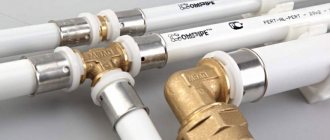Metal pipeline systems are gradually being replaced by cheaper and more practical plastic analogues. One of the most popular materials is low-density polyethylene or HDPE, from which not only the pipes themselves are made, but also a significant part of the connecting elements (fittings). With their help, you can easily design and build a pipeline system of any complexity that will last for many years.
Purpose of fittings and classification
Any pipeline structure has inlets, outlets, branches, connection points or installation of shut-off elements. The use of fittings allows you to install the pipeline quickly and easily, and make the pipeline joints strong and durable.
The devices are used for the following purposes:
- Connection of pipes of both identical and two different diameters.
- Installation of pipeline system branches.
- Pipeline turning device.
- Installation of plugs, taps, and other elements of shut-off valves.
The division of connecting elements into the following categories is accepted:
- By design: collapsible and non-dismountable.
- By connection method: compression, welded, electric welded.
- According to the degree of mobility: rigid (monolithic) and flexible.
- According to the uniformity of the pipes being connected: straight fittings are used to connect pipes of the same diameters, reduction fittings are used to connect products with different sections.
Note! For the best compatibility of the fitting and HDPE pipe, it is more correct and practical to purchase products from one manufacturer. It is better to prefer more expensive products from popular and well-established brands over cheap products from little-known companies.
PEX
The method of joining cross-linked polyethylene pipes uses the shape memory inherent in the polymer: if you stretch the end of the pipe, after a short time it will return to its previous size. The fitting is an ordinary herringbone fitting with a fixing sleeve.
Fitting for connecting PEX pipes.
To install the connection, a manual or electric expander is used.
Expander for connecting cross-linked polyethylene pipes.
The order of assembly of the connection is quite predictable:
- A sleeve is put on the pipe;
- The edge of the pipe is stretched with an expander;
- A fitting is inserted into it;
- After the fitting is securely crimped, the sleeve is placed on top of it.
Methods for connecting HDPE pipes
You can connect two pieces of plastic pipe in various ways. The most commonly used method is a welded method, or a connection using compression fittings.
Fittings for welding are produced by casting a part of the required configuration from polymer materials. To give the elements additional strength, the procedure is carried out under pressure. The cost of such products is low, but for installation you will definitely need a special soldering machine.
We recommend reading: How to clean drains using caustic soda?
The principle of operation of the device is to strongly heat the joining elements (in this case, the end of the pipe and the fitting) and connect the molten plastic surfaces to each other.
To obtain an even and durable seam, several important points should be taken into account:
- It is necessary to accurately maintain the heating time, which varies depending on the diameter of the parts being connected. Recommended temporary values can be easily found in the instructions for the device, or on the official websites of the manufacturers.
- The joining of products is carried out immediately after heating, before the parts have time to cool down.
- The joint must be smooth, without voids or sagging.
- You cannot scroll or move connected but not yet frozen elements.
Note! The welded connection method is suitable for pipelines in which the temperature of the working environment does not exceed 40°C.
If access to the welding site is difficult, you can use fittings. Such a connecting element has a built-in metal spiral in its design. When electricity is applied, the coil heats up, melting the surrounding layer of plastic and the top layer of the pipe. As it cools, the molten mass hardens, forming a homogeneous, even seam, which is not inferior in strength to the material of the pipe itself.
The use of electric welded fittings also requires some skill. Here it is important to strictly maintain the heating time of the coil. If there is not enough time, the joint may be fragile. If you overexpose it, the pipe may become deformed.
The compression fitting is completely different from the considered options both in design and installation method.
A standard fitting is a collapsible part with a diameter of 16 to 110 mm, consisting of several elements:
- A plastic housing equipped with an external thread and a lock that limits the depth of pipe insertion.
- Set of sealing rings. They are parts made of special types of rubber, ensuring complete tightness at the joint.
- Bushings acting as a press. The main task of this element is to protect the end of the pipe from high pressure of the working environment.
- Clamping rings protecting the product from mechanical damage.
- Protective covers with threads covering the joint on both sides. The surface of such a cover is most often ribbed, which allows it to be tightened tightly without the use of tools.
We recommend that you familiarize yourself with: Types of HDPE couplings and features of their installation
The use of compression fittings allows you to obtain a completely dismountable pipeline system, where it is much easier to make any adjustments, from changing the pipe flow pattern to replacing or repairing connecting elements.
Flexible and rigid connections
Rigid connection methods eliminate any movement of pipes and are performed using monolithic connecting parts. They are cheaper and suitable for solving everyday problems - the construction of pipeline heating systems, water and gas supply.
Flexible types of fittings are less common. The main area of application is the installation of pipeline systems in the ground, where minor movements of soil layers are possible. Such products allow slight vibrations of pipes (no more than 3-5 mm), and also withstand small bends at the junction.
It is important! The flexible fitting does not lose at all in terms of strength and tightness, but its cost is significantly higher than that of its rigid counterparts.
Where to buy and what to look for
When starting to install or repair a pipeline, you should draw a diagram of the entire system in advance and decide which fittings and in what quantity are needed. It is better to purchase polyethylene compounds in large specialized stores. Usually in such places of sale there are stands with presented samples and options for their installation. Experienced specialists will be able to answer all questions regarding docking. Each part must be inspected for deformation; there should be no cracks or chips on the fittings, as this will significantly reduce their service life or make installation completely impossible. In the store you can immediately purchase a special device for connecting pipes with plastic fittings.
Detachable and permanent connections
Detachable connections are in demand in those sections of the pipeline that provide attachment to a filter, pump, or any other element that will sooner or later need to be replaced.
There are the following types of detachable connections:
- Compression fitting. Best suited for installation of pipeline networks based on HDPE.
- Socket connection. The narrow part of one pipe is inserted into a wide socket at the end of the other. This method is not suitable for plumbing systems, since it does not provide the proper level of tightness. It is mainly used to protect cable routes.
- Flange connection. Plastic or metal flanges are welded to the ends of the pipes and secured with bolts. They are used primarily on large backbone networks.
- Threaded connection. Does not provide the required reliability; it is used in networks with low pressure of the working medium.
A permanent connection is considered more reliable. Installation will require welded or electrofusion fittings.
The welding procedure itself is carried out using various technologies:
- Press welding. Used to connect a plastic pipe product to any structure.
- Socket welding. In this case, the internal cross-section of the fitting coincides with the internal cross-section of the pipe.
- Butt welding. Two pipes of the same diameter are directly welded to each other.
- Electrofusion welding. Involves the use of thermal couplings. Such connections are considered very reliable.
We recommend that you read: Review of fittings for connecting metal-plastic pipes
Permanent connections are used when laying pipeline networks underground, or pouring them into a concrete screed.
Types of fittings by design and their application
Fittings for HDPE pipes have a different design, which largely determines the scope of application of the products:
- Equal passage. Required for joining pipeline lines of the same diameter.
- Expansion couplings. They are used to transition from one pipeline section to another.
- Bends. Necessary for installation of a rotating section of the pipeline. The most common product options make it possible to make an angle of 90, 66 and 45°. If necessary, manufacturers accept orders for the production of bends with any angle of rotation, down to tenths of a degree.
- Adapters. They help connect HDPE pipes with other materials and fittings. There are options with external or internal threads for connecting polyethylene to metal.
- Plugs, taps. Used to completely or partially block a pipeline branch.
- Crosses, tees. Needed for the construction of branched pipeline networks with three or more branches.
- Saddles. Clamps or linings designed for cutting an additional pipeline branch into an already operating circuit.
Features of installation of compression fittings
When using compression connectors, the joining sequence is as follows:
- Prepare a section of pipe: cut off the required section at a right angle (for which an ordinary hacksaw or a special pipe cutter is used), crumbs and burrs are cleaned, and chamfered.
- At the end of the pipe, the boundary of the entry into the fitting is marked, and the end of the pipe must be pushed in all the way.
- Depending on the design, the clamping nut is unscrewed from the fitting and put on the pipe, or simply loosened.
- The end of the pipe is moistened with a soap solution or water, and then forcefully inserted into the fitting.
- The cap nuts are tightly screwed onto the fitting, ensuring reliable contact.
Installation work
Before starting connection work, it is important to understand that a certain type of fitting is intended for installation of a certain type of wire system structure. If the set of parts for combination is correctly selected, then the work time will be reduced as much as possible. Although such a procedure can be classified as a simple type of work for a specialist in this field. The main thing is to consider several aspects.
For example, to connect elements such as tees, couplings and corners, you must use professional silicone sealant. This will allow the element to be securely fixed and ensure joint tightness and high sealing. Such elements must be inserted into parts with little force. To attach them to a wall or ceiling, you can use special latches, which can be pre-attached with screws. The main thing is to take into account all the features of the material, its capabilities and method of application, which are described above.











